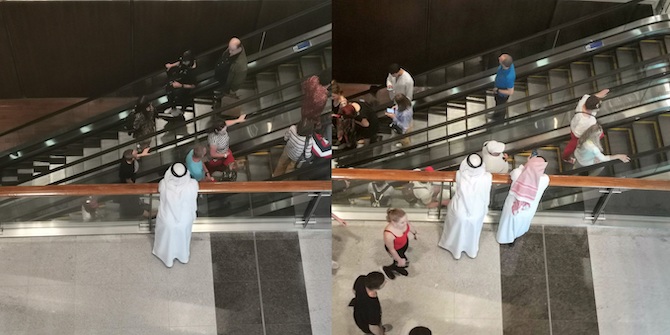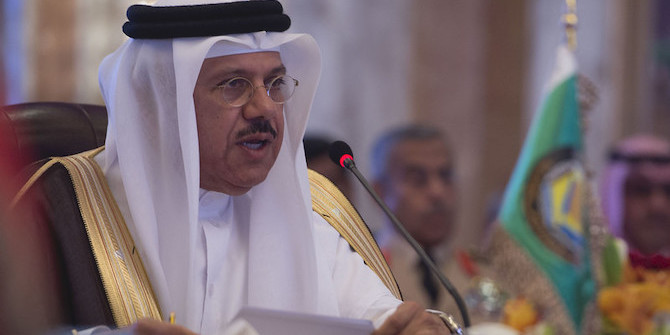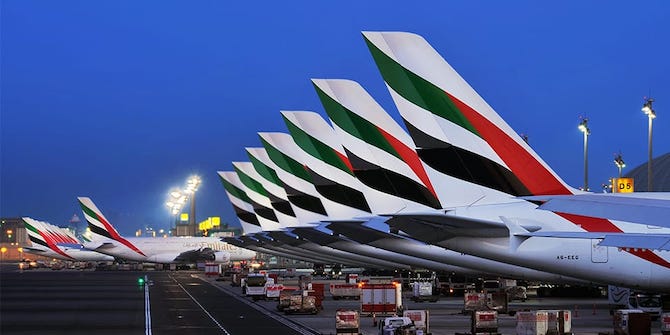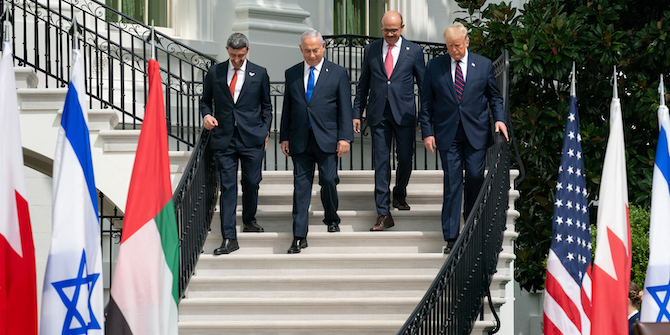By Hamdullah Baycar

The first released image of the Hope Orbiter that recently entered the orbit of Mars. Source: Stuart Rankin, Flickr
The United Arab Emirates (UAE) launched the Hope Orbiter on 19 July 2020. Upon reaching Mars on 9 February 2021, it marked an important milestone in Emirati science and discovery sectors. The Hope is expected to collect data related to Martian weather and climate dynamics. The Hope Probe, which cost around $200 million, was developed by Mohammed Bin Rashid Space Centre (MBRSC) in partnership with the University of Colorado, Boulder, the University of California, Berkeley, and Arizona State University. The collaboration with these US institutes, along with the Japanese contribution to this mission (as the rocket was bought from Japan and lifted off from a Japanese island), however, brought the Emiratis’ role in this mission into question. The UAE leadership was, in fact, aware of this concern beforehand because they warned the students and researchers who went to the US to be as involved as possible in the construction of the Hope Orbiter.
Omran Sharaf, the project manager of the Mission, reported that the UAE leadership directly instructed them to go to the US to learn about the construction of the Hobe Orbiter, not to buy it. As Sharaf explains, the UAE leadership expects to reap many advantages from this mission, including scientific advancement and inspiring schoolchildren. The mission, though, was not restricted to these benefits. The UAE masterfully represented the mission as an achievement of Arabs, saying that the UAE represents the voice and hope of all Arabs, particularly considering the uneasy years that many Arab countries have been experiencing. Another benefit that the UAE expected was to utilise Dubai’s never-ending quest to attain superlatives as a part of their PR campaign. One final achievement and expectation is that of demonstrating the visionary leadership that the UAE has, especially when the rest of the Arab countries are suffering from instability and conflicts, which bring the legitimacy of their authoritarian leaders into question.
Creating Scientific infrastructure and a Knowledge-Based Economy
The mission’s main credit should be given to Dubai more than Abu Dhabi and the Emirati federal government. As an emirate whose economy is based on non-oil sectors (mostly tourism, transportation and construction), Dubai aims to diversify its economy, with education and R&D being no exceptions. In fact, Dubai is home to more universities than any other emirate in the UAE, encouraging the establishment of foreign university branches there, such as the University of Birmingham and the University of Manchester.
Moreover, it created the Knowledge and Human Development Authority to oversee the quality of these private educational institutions. By initiating these steps, Dubai (and the UAE) aims to build scientific infrastructure that will eventually transform Dubai and the UAE into a home for science and R&D. The Hope Mission should therefore be considered from this perspective as well. Instead of building the whole educational and scientific requirement at home, they import the necessary knowledge by offering apprentice-like training with researchers in the United States. Incidentally, sending students to the West or bringing trained, well-known scholars back home is not a recent development, not only for the UAE but also for the region as a whole. The UAE, Saudi Arabia, Qatar, and the rest of the GCC are well-known for sending students abroad and bringing scholars back to their home country in the hope that they will improve the quality of their institutions at home.
Thus the creation of the Mohammed Bin Rashid Space Centre, the sending of the Hope Probe to Mars and other earth observation satellites into orbit, and the training of their first astronaut (Hazza Al Mansouri) should all be considered as achieving the aim of creating a knowledge-based economy and infrastructure for home-grown science by expediting the long process of acquiring knowledge.
Representing the Arabs and Visual Leadership
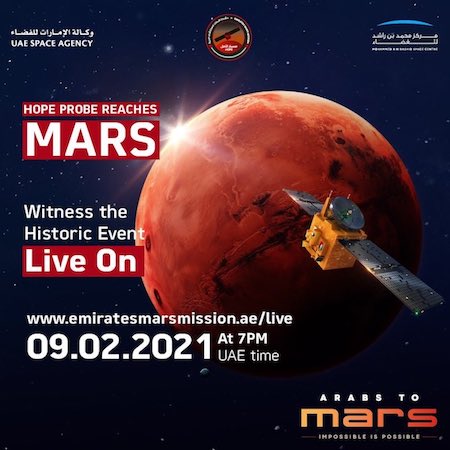
The UAE Space Agency and Mohammed Bin Rashid Space Centre launched a PR campaign to mark the Hope Probe reaching Mars. Source: @HopeMarsMission, Twitter
#ArabstoMars was the hashtag used by UAE leaders and institutions when the Hope Orbiter was launched until it reached Mars on 9 February 2021. Moreover, Emirati leaders and institutions changed their profile picture to state ‘09.02.2021, Arabs to Mars’ in both English and Arabic on their respective Twitter accounts. Affiliation of the achievement to its Arabness is not a coincidence; rather, it has historical roots. By emphasising the Arabness of the mission, Emiratis implicitly present themselves as an advanced member of the Arab world. Considering the long oriental notions regarding Arabs, the UAE presents itself as the gateway to the advancement of the wider Arab world. This makes even more sense when considering the recent gravity shift of the Arab world from Baghdad, Damascus and Cairo to Dubai, Abu Dhabi, and Doha.
Visionary leadership is a tool that the UAE has used in its nation-building and identity construction. As a federation of seven emirates with relatively few ideological stances, the UAE aims to promote its founding father ethos and visionary leadership. The space programme is attributed to the dream and vision of Sheikh Zayed. The successful arrival of Hope Orbiter on Mars was also attributed to the UAE leaders.
The Superlative Obsession and PR Campaign
The UAE, particularly Dubai, is a master at advertising, both in traditional (e.g., sponsoring sports teams like Arsenal and conducting online campaigns) and non-traditional ways (e.g., having news that prestigious Western media will cover). The second method includes the long obsession with achieving superlatives, from creating the longest hotel on earth to manufacturing the largest picture frame. The UAE, particularly Dubai, has a good strategy of using every possible topic to attract foreign news coverage, thereby bolstering their PR.
Many considered the Hope Mission as no more than a PR campaign. David Rosenberg, in his opinion piece in Haaretz, was among those who considered it as such. Rosenberg, of course, underestimated the mission’s impact on Emirati youth. Even if one disregards its possible impact on creating new home-grown Emirati scientists, this programme (along with other projects such as the Moon Mission, the astronauts’ programme, and other satellite programmes) is expected to attract many institutions and scientists to come to the UAE. Regardless of whether or not the Hope Orbiter’s main aim was a PR campaign (as Rosenberg claims), it should at least be viewed as a significant motivation for the Mars Mission.



